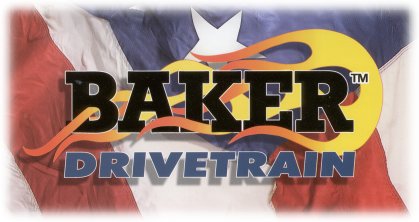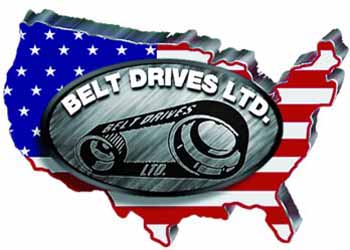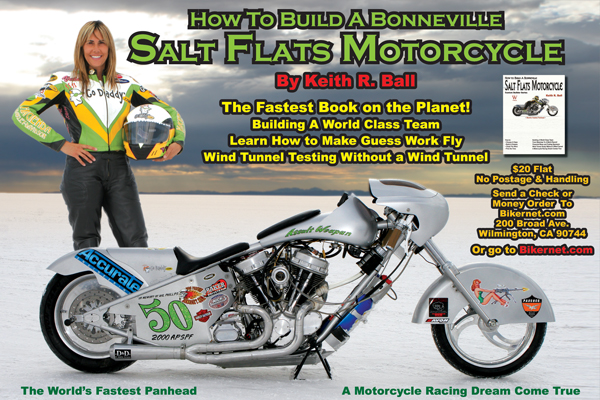
This will switch, change and fluctuate through out the process, but the notion is simple—Build The World’s Fastest Panhead. Of course there’s no goddamn Panhead class, but what the hell. We’ve never followed any rules in the past, why start now. I’ll ramble about racing on the salt, some of the rules and some of the notions behind our concept. See if you can keep up.
I joked at the Bubs International Speed Trials on Bonneville Salt flats for 2006 that I tried to learn something daily. At Bonneville, surrounded by devoted racers, and Salt snorting maniacs I learned speed info by the minute. Some of the key elements we absorbed were aerodynamics and gearing. Our code this year will be to build a bike fitting our rider, Valerie Thompson, comfortably and like a glove, to be a wing slicing through the air. It needs to move comfortably through the atmosphere, free to make the speed of 200 mph and yet handle like a dream. No streamlining. We’re shooting for an open bike, but the rules and regs are delicate. There’s a trick to staying out of the partially streamlined class, yet making the bike as aerodynamic as possible.

I learned from old salts, like Mil Blair, that my thinking was somewhat accurate. If we follow the wing notion, the front end will handle and remain stable while the tail will allow the wind to close around the chassis without creating drag on the power train. This is critical to world land speed record success according to the masters of the salt, like Wink Eller, who now works for BDL between races.

Speaking of Drive Trains. We ran an Accurate Engineering, 120-inch Panhead motor last year for shits and grins. But I’m sticking with this power plant for several reasons. First, it was built by one fine engine builder and a brother, Berry Wardlaw, the boss of Accurate, who is passionate about this industry, every goddamn thing he does and speed. He’s my partner in this endeavor and a brother I can reach out to for anything, at any time. He bleeds 60 weight and snorts nitrous. Let me finish about the engine, then I’ll shift to nitrous systems. Three notions in the engine reasoning department. First, is the Panhead heritage. Panheads were built from the year I was born, 1948 up to 1965, the year before I graduated from High School. They’re my favorite H-D engine configuration, and when it comes to Bonneville racing they add a sense of class. Finally, who the hell would bring a 50-year-old technology to Bonneville, to set a record except the Bikernet 5-Ball Racing nuts.

One of the myriad of things I noticed on the salt was the power notion. Lotsa guys feel it’s all about power and engine displacement, yet a 50 cc streamliner is capable of 130mph and a 440 cc open-bike Buell Blast also cut through the air at 135 mph. Also, when a guy looks at me like I’m nuts, to even mention 200 mph, I envision a stock Hyabusa, capable of 200 mph on a freeway. Keep those mysteries in mind as we stumble through this effort.
The Tranny will be a direct drive performance Baker 5 or 6 speed (we haven’t decided), linked to the engine with a BDL belt and clutch system. We will run chain to the rear to allow easy rear wheel sprocket alterations. Mil Blair recommended Hyabusa wheels for the 200 mph reliability and design. I will study those wheels but hope to run a solid U.S.A built wheel in the rear and nearly solid wheel in the front (by the rules 30 percent of the front wheel area must be open). I want to prevent any loss of power or additional drag from the paddle-wheel effect of wheel spokes or billet shapes.

We are working with Leo De Orio on a shapely girder front end to enhance the aerodynamics of the front end and handling. One of Leo’s front ends led Roger Goldammer’s build-off Bonneville effort last year, and it was sleek and killer looking. I’m hoping to run a 19 front and 18 rear, but keep both wheels narrow, especially the rear wheel for aerodynamic purposes. There’s a slippage consideration. At speeds some bikes loose grip because the rear end is too light, the tire too hard, or not enough patch on the ground. We won't worry much about the weight issue. Having weight at Bonneville is a plus. Many bikes are small and light. They want to lose traction and fly away at speeds on the salt. We will run the oil bag under the transmission and perhaps additional low center of gravity weight to hold her down at speeds.

Our plan is to build the roller first, then fly Valerie out from Phoenix to the Wilmington, CA ghetto and the Bikernet Headquarters. We hope to form a mold of her lovely-self while straddling the bare frame. We want her to become apart of the bike, and build it in such a way that it is absolutely comfortable and manageable to ride. The more comfortable and vibration free, the easier it is to handle and maintain vision at 200 mph. Besides we want our pilot to be as comfortable and confident as possible. It’s official now. She took 6th place in Destroyer points standings for 2006 and was 11th in 87 Destroyer riders nationwide.

One of our crazed goals is to make this an open bike. There’s several classes: Production, modified, special construction, modified partial streamlining, special construction partial streamlining, sidecar, sidecar streamliner and streamliner.
There’s also a number of engine classes:
Production
Production Push Rod
Production Supercharged
Production Vintage
Modified Engine: Gasoline
Push Rod Engine: Gasoline
Unlimited Engine: Gasoline
Supercharged Engine: Gasoline
Supercharged Pushrod Engine: Gasoline
Supercharged Vintage Engine: Gasoline

Then the list starts all over again with Fuel at the end. Wink Eller is the master of classes. He’s a racing maniac and when he started chasing World Land Speed Records he studied the Southern California Timing Association Record and Rule Book and sought achievable records. He searched the record books for untouched records and built bikes specifically for low or never-set records. There’s another category I left out, the engine displacement button. Those categories run from 50 ccs all the way to 3000.
50
100
125
350
500
650
750
1000
1350
1650
2000
3000

Get this. There are three sanctioning bodies. The SCTA mentioned above authorizes racing at the El Mirage lake beds in California and two events in Bonneville: Speed Week and the World Finals. Bub’s event is only sanctioned by the AMA and FIM, the European sanctioning body. While standing on the Salt and trying to figure out what category the Bikernet Salt Shaker was in last year, I discovered that my 120-inch Panhead fell in the special Construction, Pushrod, fuel or gas, 2000 cc category. There was no record for my bike. Unbelievable. I consider myself lucky, but that roll-of-the-dice took the cake.
That’s just a taste of our notions. Hang on as we plan, change the sketch and move forward. Berry’s studying nitrous systems. Leo is working on handling, rake and trail. Chris Kallas, the artist behind our sketch, is working with Valerie on more info to refine our drawings. I’m working with Rick Krost of US Choppers on our frame. Hang on.
